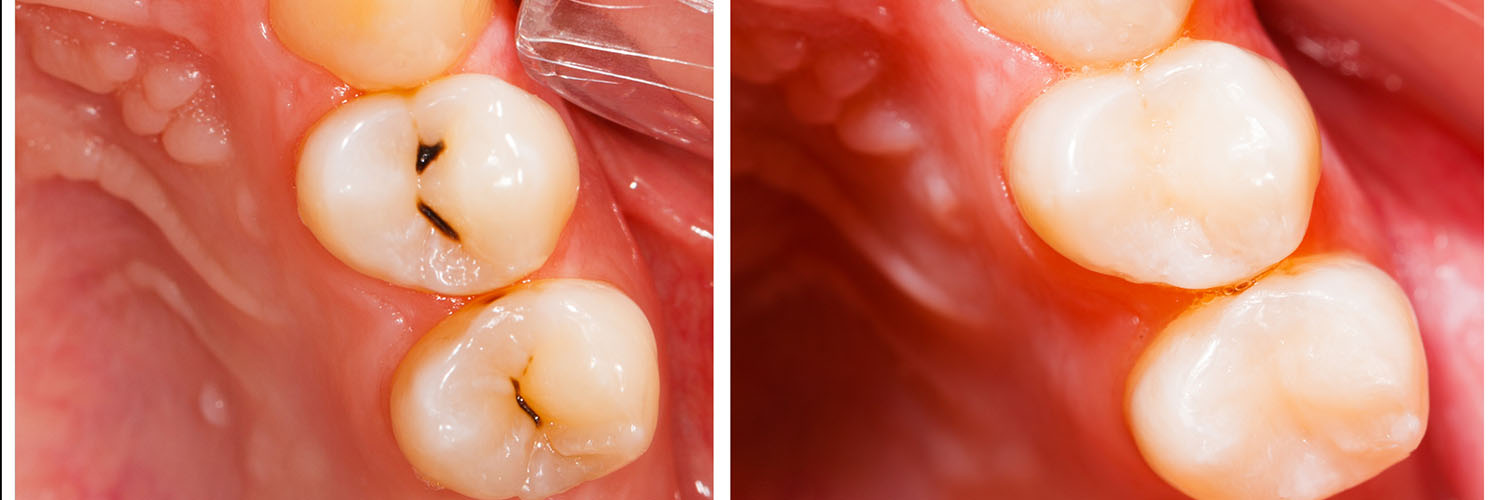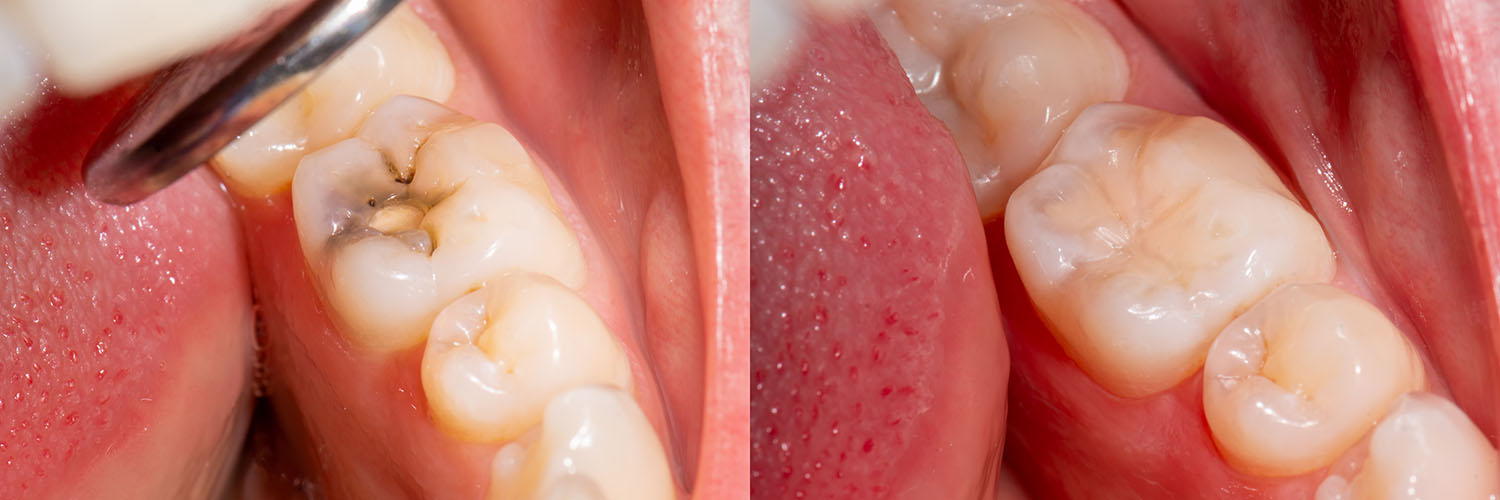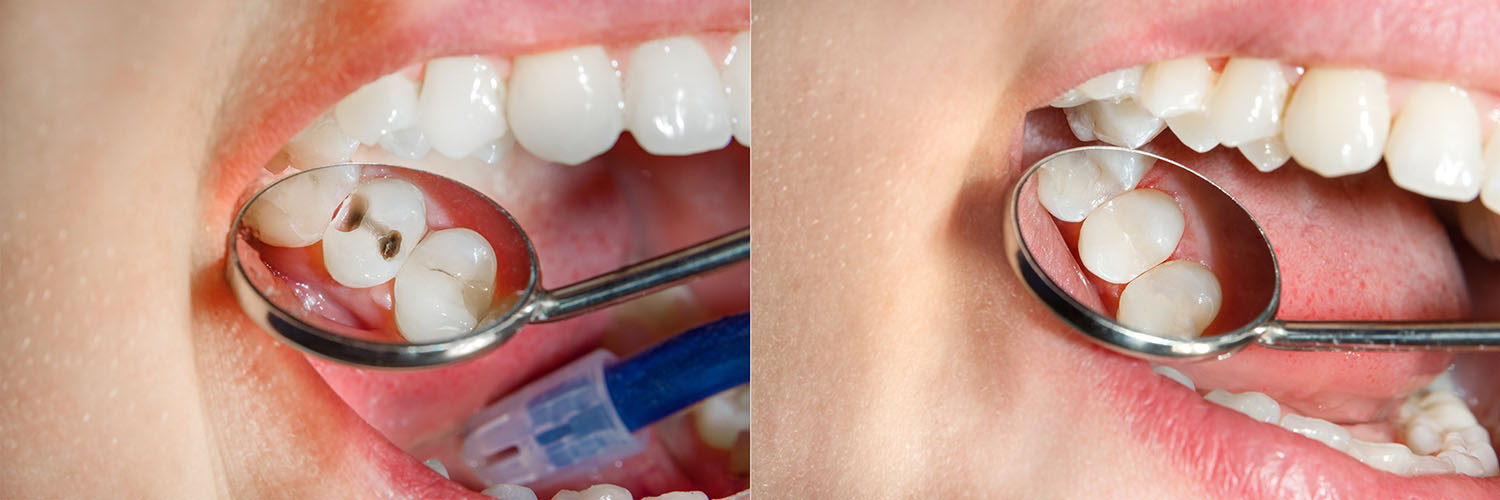
When a tooth’s surface is weakened by decay or minor damage, a dental filling repairs that area and restores normal chewing function. Fillings are designed to recreate the tooth’s natural shape, protect the remaining enamel, and prevent further breakdown of the structure so patients can eat and speak comfortably.
Teeth decay remains a common health concern across all age groups, and placing a filling is one of the most frequently performed restorative procedures in dentistry. Because the goal is to preserve as much healthy tooth as possible, modern techniques focus on targeted removal of decay and careful rebuilding of the affected area to maintain long-term oral health.
Our team approaches each restoration with attention to both durability and appearance. At Cherokee Smiles Dental we use up-to-date methods and materials to deliver restorations that blend with your smile while protecting teeth from future damage. We’ll walk you through the recommended approach so you understand how the chosen solution meets your needs.
Repairing teeth is an ancient human practice, and restorative materials have evolved dramatically over time. Early attempts at treating dental problems date back centuries, but the last couple of hundred years brought major innovations — from metal alloys to the tooth-colored composites and ceramics we use today.
While older metal restorations provided strength and longevity, newer materials were developed to offer improved aesthetics and biological compatibility. These advancements allow clinicians to match restorations to natural tooth color, bond restorations directly to enamel and dentin, and reduce the amount of healthy tooth that must be removed during treatment.

Choosing a filling is a clinical decision that balances strength, appearance, longevity, and the location of the tooth. Front teeth often benefit most from materials that closely mimic natural enamel, while molars — which endure significant chewing forces — may require options that favor durability. Your dentist will explain the trade-offs and recommend the material that best fits your oral health and aesthetic goals.
Material choices have expanded in recent decades, and each type has distinct advantages. Some options bond directly to the tooth, helping to seal and reinforce weakened areas. Others are crafted outside the mouth and cemented into place for exceptional wear resistance. The right selection depends on factors like cavity size, bite forces, and whether the restoration must match surrounding teeth.
We’ll review each viable option with you, describing how the material performs over time and what kind of maintenance to expect. This collaborative approach ensures you are comfortable with the chosen treatment and understand how it supports both function and appearance.
Composite resins are versatile, blend with natural enamel shades, and bond directly to the tooth structure. They are commonly used for visible areas and smaller cavities because they require less removal of healthy tooth tissue. Composites are placed in layers and cured to form a durable restoration that can also be shaped to improve a tooth’s contour.
Amalgam has a long track record for strength in high-stress areas of the mouth. Although it does not offer the cosmetic benefits of tooth-colored materials, amalgam remains a reliable option for large restorations in posterior teeth where resilience to heavy chewing is a priority.
Glass ionomer materials bond chemically to tooth structure and release fluoride over time, which can help protect the restored tooth from recurrent decay. They are often chosen for use in children’s primary teeth, areas near the gumline, or as temporary restorations when a conservative approach is preferred.
Ceramic restorations are fabricated to precise specifications and then bonded into place. They combine excellent esthetics with superior wear resistance and are well suited for larger repairs where a direct filling would be less predictable. Because they are made outside the mouth, they require at least two visits or the use of same-day CAD/CAM technology.
Gold restorations provide longevity and gentle behavior toward opposing teeth, and they have been used successfully for many years. While less common today because of aesthetic preferences, gold remains a strong option when longevity and biocompatibility are the priority.

A filling appointment begins with a careful exam and diagnosis to determine the extent of decay or damage. Once the treatment plan is agreed upon, the area is numbed so the procedure is comfortable. Modern local anesthetics are effective and allow the clinician to work precisely without causing pain.
To remove decay, your dentist may use a traditional handpiece (drill), an air-abrasion device, or a dental laser depending on the situation and the location of the lesion. The remaining tooth structure is shaped as needed to accept the chosen restoration, and if a bonded material is selected, the surface is prepared to optimize adhesion.
Placement techniques vary by material: direct restorations like composites are built up and cured in the mouth, while indirect options such as ceramic inlays are fabricated in a lab or with in-office milling equipment before being cemented into place. For more extensive cases, a temporary filling may be placed while a custom restoration is completed.
Patients with dental anxiety should discuss comfort options with the team. We offer approaches to help patients feel relaxed and informed during treatment, and we will review any specific needs before beginning the procedure.
Immediately after a filling, it’s common to feel some numbness from the anesthetic; normal sensation typically returns within an hour or two. Until the numbness subsides, take care when eating or drinking to avoid biting soft tissues. Once sensation returns, you can resume normal activities unless otherwise advised by your clinician.
Sensitivity to hot, cold, or pressure can occur after a restoration — especially when decay was deep or near the nerve — and this usually diminishes over days to weeks. Persistent or worsening pain should be reported so it can be evaluated promptly. Regular oral hygiene, including brushing and flossing, helps protect both natural tooth structure and restorations from new decay.
Fillings are durable, but no restoration lasts forever. Factors that influence longevity include the material chosen, the size and location of the restoration, chewing habits, and routine dental care. During follow-up visits your dentist will evaluate restorations for wear, marginal integrity, and any signs of recurrent decay so that timely maintenance can be provided.

Dental fillings are a predictable and effective way to stop decay, restore tooth form, and maintain oral function. By selecting appropriate materials and following careful clinical techniques, a well-placed filling can preserve a tooth for many years while maintaining a natural appearance.
If you have questions about what type of restoration is right for you, or if you’re experiencing symptoms that might indicate a cavity, schedule an evaluation so a personalized treatment plan can be developed. Our team is available to explain options and help you make an informed choice that balances durability, comfort, and appearance.
To learn more about restorative choices or to discuss a specific concern, please contact us for additional information. We’re here to help you protect your smile and maintain healthy teeth for years to come.

If the pleasure of eating a delicious bowl of ice cream or sipping a soothing cup of tea gets overshadowed by dental pain that makes you wince; it's time to contact our office. As skilled providers of care, we'll determine what's causing your discomfort and perform the treatment required to alleviate your symptoms and get you back on the road to oral health.
Cavities develop because of an infectious process that causes progressive damage to tooth structure. Despite starting as a pinpoint defect on the outermost enamel layer of your tooth, untreated dental decay progressively compromises more and more healthy tooth structure as it works its way to the inner layers of your tooth.
Yes, you can still develop tooth decay on other surfaces of the tooth, around the margins of an old filling, or in fewer instances, recurrent decay underneath it. For this reason, it's essential to maintain excellent oral hygiene, a diet low in sugary beverages and sweets, and be sure to visit our office for routine checkups and care. While tooth decay is second only to the common cold in frequency, it's almost entirely preventable.
We value the time and comfort of our patients. If cavities are located on adjacent teeth, or in the same section of your smile, it may be possible to treat more than one tooth during your visit. However, how much is done each visit depends on several factors. We keep our patients well informed and tailor every treatment plan and visit to address their unique needs.
Addressing concerns on the presence of elemental mercury in silver fillings, the American Dental Association (ADA), The Center for Disease Control and Prevention (CDC), the FDA, and the World Health Organization have all stated that amalgam restorations do not pose a risk to health. However, individuals with allergies or sensitivities to the metals in dental amalgam are advised to pursue other restorative options.
Dental fillings are performed under local anesthesia to help ensure your comfort throughout the entire procedure. The involved tooth remains completely numb for the extent of your visit. Within one or two hours after the procedure is completed, the local anesthetic will gradually wear off, and normal sensations return.
A tooth-colored composite filling is fully hardened and set by the end of your visit. However, we may advise you to wait a couple of hours until the local anesthesia has completely worn off. This advice is to help ensure you don't accidentally bite your lip, cheek, or tongue while still numb.
The lifetime of a dental filling varies depending on the type of material used. While popular dental materials can last a decade or more with proper care, they can degrade over time, wear down, or even break. When this happens, you may experience some tooth sensitivity, a jagged edge, or a loose or dislodged piece of filling material. Whatever the case may be, it's essential to get the filling replaced before the tooth sustains further damage or other consequences arise. Beyond taking good care of your smile to help ensure the longevity of your fillings, our office regularly checks the status of your existing fillings as part of a routine checkup exam.
Dental fillings are an essential investment that serves to preserve and protect the health of your smile. With that said, how much a filling costs depends on the number of surfaces of the tooth involved and the filling material that is used. Amalgam restorations are the most economical. While tooth-colored composite fillings have a slightly higher cost, they offer the added benefits of being metal-free and much more aesthetically pleasing. Ceramic fillings, inlays, and onlays are more expensive than the preceding options but provide outstanding, long-lasting, and natural-looking results.
Dental insurances typically cover the cost of dental fillings. While we work with you to maximize your insurance benefits, there may still be an out-of-pocket expense. At the office of Cherokee Smiles Dental, we strive to help you begin care without any additional financial stress or delay.
A dental filling restores the form and function of a tooth that has been weakened by decay or minor damage. The filling removes infected material and rebuilds the tooth so normal chewing and speaking can continue without pain. By sealing the treated area, a filling also helps prevent further breakdown of the remaining enamel and dentin.
Fillings are among the most common restorative procedures because they preserve natural tooth structure and address problems before they require more extensive treatment. Modern techniques focus on removing only the decayed portion and conserving healthy tissue whenever possible. Early intervention with a filling often reduces the risk of future complications such as infection or the need for a root canal.
Selecting a filling material involves balancing strength, appearance and the tooth's location in the mouth. Front teeth and visible areas typically benefit from tooth-colored materials that closely mimic enamel, while molars may require tougher materials that withstand heavy chewing forces. Your clinician will consider cavity size, bite patterns and aesthetic goals when recommending an option.
Each material has distinct advantages: some bond directly to the tooth to reinforce weakened areas, while others are fabricated outside the mouth for exceptional wear resistance. The dentist will explain the trade-offs in longevity and maintenance so you can make an informed decision. A collaborative discussion ensures the chosen restoration fits both functional needs and cosmetic expectations.
A filling visit begins with a careful exam and diagnosis to confirm the extent of decay or damage. After discussing the treatment plan, the area is numbed with a local anesthetic so the procedure is comfortable and precise. The dentist then removes decay using a handpiece, air abrasion or a dental laser, prepares the remaining tooth structure and places the selected restoration.
Direct materials such as composite resins are built up and cured in layers in the mouth, while indirect options like ceramic inlays are fabricated and then bonded into place. In some cases a temporary restoration is used while a custom piece is made. Patients with dental anxiety should discuss comfort options with the team so they feel relaxed and informed throughout the visit.
Modern local anesthetics make the procedure itself comfortable for most patients, and the dentist will confirm numbness before work begins. Minor pressure or vibration may be felt, but sharp pain is uncommon when anesthesia is effective. If you experience discomfort during treatment, communicate with your clinician so additional numbing or adjustments can be made.
After the appointment, it is normal to have lingering numbness for an hour or two and temporary sensitivity to hot, cold or pressure for several days. This sensitivity usually subsides as the tooth heals, but persistent or worsening pain should be evaluated promptly. The dental team can advise on over-the-counter pain relief and specific care steps if symptoms continue.
Good oral hygiene is the foundation for protecting both natural teeth and restorations; brush twice daily and floss once a day to remove plaque and prevent recurrent decay. Avoid using a restored tooth as a tool for opening packages and be mindful of chewing very hard items that could stress the material. Regular dental checkups allow the dentist to monitor the filling for wear, marginal integrity and any signs of leakage.
At Cherokee Smiles Dental we emphasize routine exams and cleanings as part of a long-term maintenance plan for restorations. If you notice a change in bite, persistent sensitivity or a sharp edge on a restoration, schedule an evaluation so repairs can be made before further damage occurs. Timely attention to small issues often prevents the need for more extensive treatment later.
Longevity varies by material, the size and location of the filling, oral hygiene and individual chewing habits. Smaller composite restorations may last many years with proper care, while larger restorations or those in high-stress areas may show wear sooner. Regular dental exams allow the clinician to identify gradual wear, marginal breakdown or recurrent decay early on.
Replacement is recommended when a filling shows signs of failure such as cracks, recurrent decay at the margins, or a change in bite that causes discomfort. The dentist will evaluate restorations during routine visits and recommend the least invasive option that preserves tooth structure. Proactive maintenance helps extend the overall health of the restored tooth.
Tooth-colored composite resins offer clear aesthetic advantages because they can be matched to the natural shade of the tooth and shaped to restore contour. Composites also bond directly to enamel and dentin, allowing for more conservative preparation and reinforcement of the remaining tooth. Amalgam retains a role where extreme durability is required, particularly for very large restorations in back teeth.
The choice between composite and amalgam depends on clinical needs such as cavity size, location, and the patient’s bite forces. Your dentist will explain performance differences, expected longevity and maintenance considerations to guide the selection. Prioritizing both function and appearance results in a restoration that meets your long-term oral health goals.
Yes. Materials such as glass ionomer cements are commonly used in pediatric dentistry and in areas near the gumline because they bond chemically to the tooth and release fluoride over time. This fluoride release can help reduce the risk of recurrent decay in susceptible areas, and glass ionomers are often used when a conservative or interim restoration is preferred. Their ease of placement makes them suitable for situations where moisture control is a concern.
For permanent restorations in children or adults, the dentist will weigh longevity and aesthetic needs against the benefits of fluoride release and adhesion. Preventive strategies like sealants and topical fluoride treatments may also be recommended to protect vulnerable teeth. A tailored approach ensures the selected material supports both short-term protection and long-term oral health.
Yes, ceramic inlays and onlays are an excellent option for larger cavities where a direct filling would be less predictable or where enhanced esthetics and wear resistance are desired. These restorations are fabricated to precise specifications and then bonded into place, combining the look of natural enamel with superior durability compared with some direct materials. Same-day CAD/CAM technology allows many practices to design, mill and place ceramic restorations in a single visit.
Indirect restorations are particularly helpful when conserving tooth structure is important but a robust, long-lasting repair is required. The dentist will recommend an inlay or onlay when it offers better long-term results than a direct filling. Treatment planning considers the extent of damage, occlusion and the patient’s restorative goals.
Contemporary restorative dentistry emphasizes minimally invasive techniques that target only decayed or damaged tissue while preserving healthy enamel and dentin. Adhesive materials like composites bond to the tooth and often require smaller access preparations than traditional methods, allowing more of the natural structure to remain. Tools such as air abrasion and dental lasers can remove decay selectively, reducing the need for extensive drilling in many cases.
This conservative approach helps maintain tooth strength and reduces the likelihood of future complications that necessitate larger restorations. Your dentist will explain the chosen method and how it balances durability with preservation of tooth structure. Routine monitoring and preventive care complement these techniques to support long-term oral health.

Need to schedule an appointment or have questions about our services?
Our friendly team makes it easy to get the care you need. Whether you call or submit our online form, we’re here to guide you every step of the way.
Don’t wait to start your journey to a healthier, brighter smile—contact us today and experience personalized dental care you can trust.